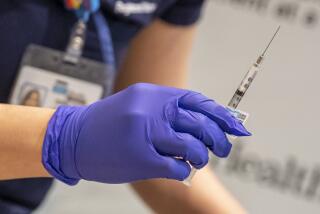AIDS Experiment May Be Conducted on Shuttle Flight
- Share via
HOUSTON — Astronauts on the first post-Challenger shuttle flight may grow crystals of a protein taken from the AIDS virus in an experiment researchers hope will lead to drugs to fight the fatal disease.
The protein, reverse transcriptase, is an enzyme the AIDS virus uses to replicate its genetic material to reproduce and spread through the body, said Dr. Charles Bugg, a University of Alabama-Birmingham researcher.
“AIDS would never infect human cells without using this enzyme,” said Bugg, coordinator for protein experiments that will be conducted aboard Discovery. The shuttle is scheduled to fly later this year.
Researchers want to grow the crystals to decipher its structure. Crystals grown in space are not distorted by gravity while they form.
Scientists hope to learn how the AIDS virus takes over the genetic machinery inside a cell and use that knowledge to develop a drug to conquer acquired immune deficiency syndrome.
Dr. Tom Krenitsky at Burroughs Wellcome in Research Triangle Park, N.C., developed the experiment. The National Aeronautics and Space Administration is making sure it meets safety guidelines.
More to Read
Sign up for Essential California
The most important California stories and recommendations in your inbox every morning.
You may occasionally receive promotional content from the Los Angeles Times.








